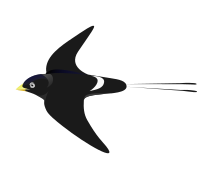
The barn swallow is the most widespread species of swallow in the world. In fact, it appears to have the largest natural distribution of any of the world's passerine, ranging over 251 million square kilometers globally. It is a distinctive passerine bird with blue upperparts and a long, deeply forked tail. It is found in Europe, Asia, Africa and the Americas. In Anglophone Europe it is just called the swallow; in Northern Europe it is the only common species called a "swallow" rather than a "martin".

The swallows, martins, and saw-wings, or Hirundinidae, are a family of passerine birds found around the world on all continents, including occasionally in Antarctica. Highly adapted to aerial feeding, they have a distinctive appearance. The term "swallow" is used colloquially in Europe as a synonym for the barn swallow. Around 90 species of Hirundinidae are known, divided into 19 genera, with the greatest diversity found in Africa, which is also thought to be where they evolved as hole-nesters. They also occur on a number of oceanic islands. A number of European and North American species are long-distance migrants; by contrast, the West and South African swallows are nonmigratory.

The Eurasian crag martin or just crag martin is a small passerine bird in the swallow family. It is about 14 cm (5.5 in) long with ash-brown upperparts and paler underparts, and a short, square tail that has distinctive white patches on most of its feathers. It breeds in the mountains of southern Europe, northwestern Africa and across the Palearctic. It can be confused with the three other species in its genus, but is larger than both, with brighter tail spots and different plumage tone. Many European birds are resident, but some northern populations and most Asian breeders are migratory, wintering in northern Africa, the Middle East or India.

The red-rumped swallow is a small passerine bird in the swallow family. It breeds in open hilly country of temperate southern Europe and Asia from Portugal and Spain to Japan, India, Sri Lanka and tropical Africa. The Indian and African birds are resident, but European and other Asian birds are migratory. They winter in Africa or India and are vagrants to Christmas Island and northern Australia.

The violet-green swallow is a small North American passerine bird in the swallow family. These aerial insectivores are distributed along the west coast from Alaska to Mexico, extending as far east as Montana and Texas. With an appearance very similar to the tree swallow, these individuals can be identified by the white rump side-patches that appear to separate their green back and purple tail. Violet-green swallows are secondary cavity nesters, found in a number of habitats including deciduous and coniferous forest. In addition to nesting in tree holes within these habitats, they are also widely observed nesting in the cracks of large cliffs.
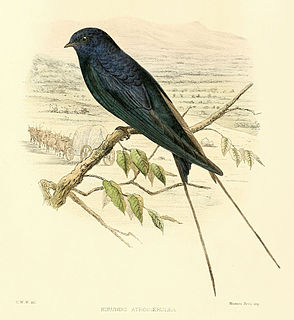
The blue swallow is a small bird within the swallow family which is in the order Passeriformes. Swallows are somewhat similar in habits and appearance to other aerial insectivores, such as the martins and the swifts. It breeds in the Afromontane, wintering north of Lake Victoria.

The mangrove swallow is a passerine bird in the swallow family that breeds in coastal regions from Mexico through Central America to Panama. It has blue-green upperparts, blackish flight feathers, a white rump, a black tail, and white underparts. It can be identified by the supraloral white streak, the white line near its eye, which only occurs in two other species of Tachycineta: the violet-green swallow and the white-rumped swallow. The sexes, although similar in plumage, differ slightly in size. The juveniles have grey-brown upperparts and white-washed underparts. This swallow's song is generally described as a soft trilling, with a rolled jeerrt call, and a sharp alarm note.
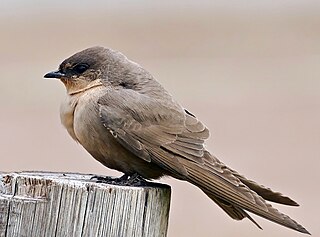
The rock martin is a small passerine bird in the swallow family that is resident in central and southern Africa. It breeds mainly in the mountains, but also at lower altitudes, especially in rocky areas and around towns, and, unlike most swallows, it is often found far from water. It is 12–15 cm (4.7–5.9 in) long, with mainly brown plumage, paler-toned on the upper breast and underwing coverts, and with white "windows" on the spread tail in flight. The sexes are similar in appearance, but juveniles have pale fringes to the upperparts and flight feathers. The former northern subspecies are smaller, paler, and whiter-throated than southern African forms, and are now usually split as a separate species, the pale crag martin. The rock martin hunts along cliff faces for flying insects using a slow flight with much gliding. Its call is a soft twitter.
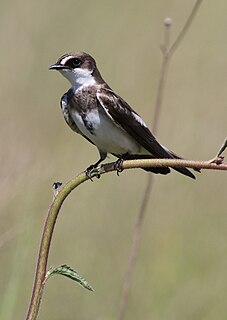
The banded martin or banded sand martin is a small passerine bird in the swallow family Hirundinidae that is endemic to Africa. It is the only species placed in the genus Neophedina.

The Congo martin or Congo sand martin is a small passerine bird in the swallow family.

The crag martins are four species of small passerine birds in the genus Ptyonoprogne of the swallow family. They are the Eurasian crag martin (P. rupestris), the pale crag martin (P. obsoleta), the rock martin (P. fuligula) and the dusky crag martin (P. concolor). They are closely related to each other, and have formerly sometimes been considered to be one species. They are closely related to the Hirundo barn swallows and are placed in that genus by some authorities. These are small swallows with brown upperparts, paler underparts without a breast band, and a square tail with white patches. They can be distinguished from each other on size, the colour shade of the upperparts and underparts, and minor plumage details like throat colour. They resemble the sand martin, but are darker below, and lack a breast band.

Delichon is a small genus of passerine birds that belongs to the swallow family and contains four species named as house martins. These are chunky, bull-headed and short-tailed birds, blackish-blue above with a contrasting white rump, and with white or grey underparts. They have feathering on the toes and tarsi that is characteristic of this genus. The house martins are closely related to other swallows that build mud nests, particularly the Hirundo barn swallows. They breed only in Europe, Asia and the mountains of North Africa. Two species, the common and Asian house martins, migrate south in winter, while the Nepal house martin is resident in the Himalayas year-round.

The white-eyed river martin is a passerine bird, one of only two members of the river martin subfamily of the swallows. Since it has significant differences from its closest relative, the African river martin, it is sometimes placed in its own genus, Eurochelidon. First found in 1968, it is known only from a single wintering site in Thailand, and may be extinct, since it has not been seen since 1980 despite targeted surveys in Thailand and neighbouring Cambodia. It may possibly still breed in China or Southeast Asia, but a Chinese painting initially thought to depict this species was later reassessed as showing pratincoles.

The African river martin is a passerine bird, one of two members of the river martin subfamily of the swallow family, Hirundinidae. When discovered, it was not initially recognised as a swallow, and its structural differences from most of its relatives, including its stout bill and robust legs and feet, have led to its current placement in a separate subfamily shared only with the Asian white-eyed river martin. The African river martin is a large swallow, mainly black with a blue-green gloss to the head and a greener tint to the back and wings. The under-wings are brownish, the underparts are purple-black, and the flight feathers are black. This martin has red eyes, a broad orange-red bill and a black, square tail. Young birds are similar in appearance to the adults, but have browner plumage. This species has a variety of unmusical calls, and displays both in flight and on the ground, although the purpose of the terrestrial display is unknown.

Bueng Boraphet is the largest freshwater swamp and lake in central Thailand. It covers an area of 224 km2 east of Nakhon Sawan, south of the Nan River close to its confluence with the Ping River. This swamp can be seen from the train window between Bueng Boraphet and Thap Krit stations on the Northern railway line.

The swamp boubou, also known as the Gabon boubou, is a species of bird in the Malaconotidae or bushshrike family. It is native to western and southern Central Africa. In the north of their range, savannah thickets constitute an important part of their habitat, while in the south they are strongly associated with river systems and marshes, for which they are named. The pair bond appears to be maintained by duetting, which in the south is generally synchronous or overlapping. It is most similar to L. major subsp. major, with which it perhaps hybridizes, but the underpart plumage is immaculate white, while the female contributes a ratchet-like note to the duet.

The Mascarene martin or Mascarene swallow is a passerine bird in the swallow family that breeds in Madagascar and in the Mascarene Islands. The nominate subspecies occurs on Mauritius and Réunion and has never been found away from the Mascarene Islands, but the smaller Madagascan subspecies, P. b. madagascariensis, is migratory and has been recorded wintering in East Africa or wandering to other Indian Ocean islands.

Brazza's martin is a passerine bird in the swallow family, Hirundinidae. It is 12 cm (4.25 in) long with grey-brown upperparts, heavily black-streaked white underparts, and a brownish tint to the breast plumage. The sexes are similar, but juvenile birds have more diffuse breast streaking and reddish-brown edges to the feathers of the back and wings. The song consists of a series of short notes of increasing frequency, followed by a complex buzz that is sometimes completed by a number of clicks.
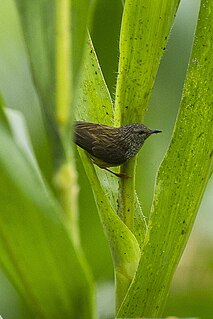
The tit hylia is a species of bird, monotypic within the genus Pholidornis. It is found in rainforests in West and Central Africa. It had been placed in the family Cettiidae, but in 2019 its assignment to a new family, the Hyliidae, was strongly supported.
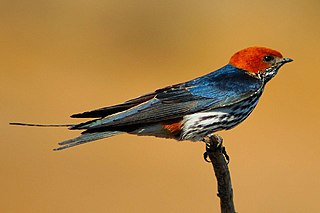
Cecropis is a genus of large swallows found in Africa and tropical Asia. The red-rumped swallow's range also extends into southern Europe, and into Australia. This genus is frequently subsumed into the larger genus Hirundo.
